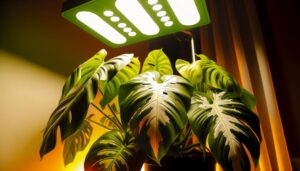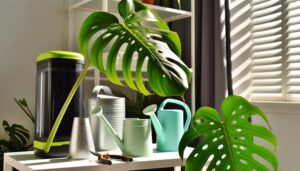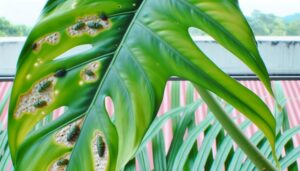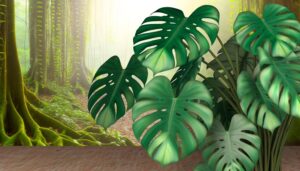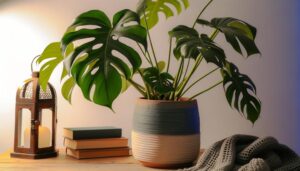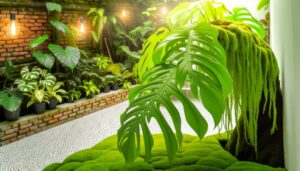Monstera Dubia Vs Monstera Adansonii
Monstera Dubia and Monstera Adansonii, both from Central and South America, thrive in humid rainforests. Monstera Dubia features heart-shaped, leathery leaves and clings while growing, needing bright, indirect light and consistent moisture.
In contrast, Monstera Adansonii has perforated, oval leaves with a vining habit, tolerating lower light and preferring slightly drier conditions. Both require well-ventilated, nutrient-rich soil and high humidity levels but differ in growth rates and watering needs.
Understanding these nuances will help you cultivate these Monstera species with scientific precision and attention to detail, enhancing their growth and health.
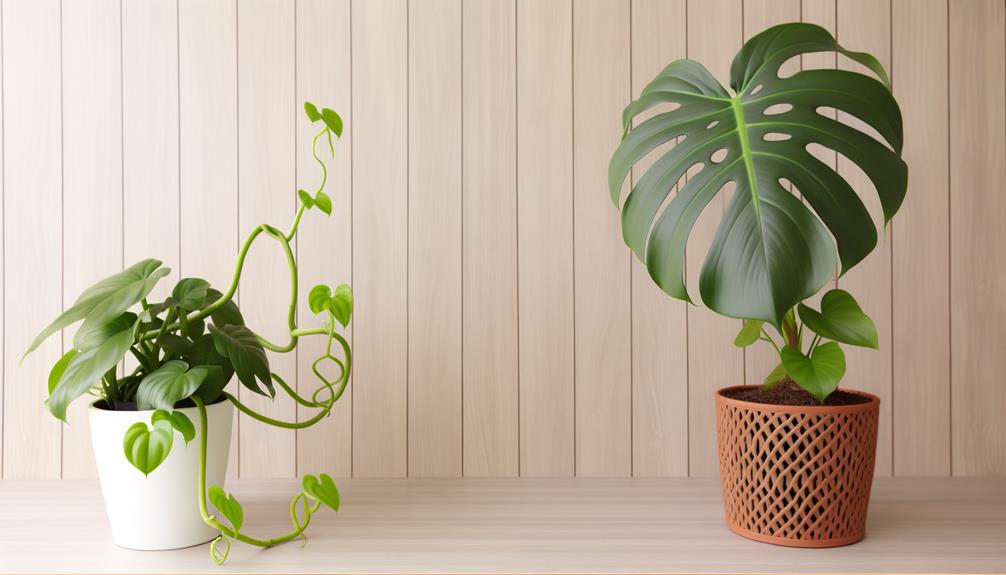
Key Takeaways
- Monstera Dubia has heart-shaped, leathery leaves; Monstera Adansonii has perforated, papery leaves.
- Dubia exhibits a slow-growing, climbing habit; Adansonii grows faster with a sprawling, vining pattern.
- Dubia requires consistently moist soil; Adansonii prefers slightly drier conditions between waterings.
- Both thrive in bright, indirect light, but Adansonii can tolerate lower light levels.
- Both plants need high humidity (above 60%) and temperatures between 65-85°F.
Origin and Natural Habitat
Both Monstera dubia and Monstera adansonii originate from the tropical rainforests of Central and South America, where they thrive in humid, shaded environments. You'll find them climbing tree trunks using their aerial roots, which allow them to anchor and absorb moisture from the air.
In their natural habitat, these plants experience high humidity levels, around 70-90%, and temperatures ranging from 65°F to 85°F. They're adapted to low light conditions, thriving under the dense canopy. The rich, well-draining, organic soil of the rainforest floor supports their growth.
You'll notice that they exhibit epiphytic behavior, meaning they often grow on other plants for support without extracting nutrients from them, relying instead on their own efficient nutrient absorption mechanisms.
Leaf Shape and Size
When comparing Monstera Dubia and Monstera Adansonii, you'll notice distinct differences in their juvenile leaves. Monstera Dubia exhibits small, heart-shaped leaves that cling tightly to surfaces, whereas Monstera Adansonii's juvenile leaves are perforated and oval-shaped.
As they mature, Monstera Dubia's leaves become larger and develop fenestrations, while Monstera Adansonii's leaves increase in size but maintain their characteristic perforations.
Juvenile Leaf Differences
Juvenile Monstera dubia leaves exhibit a more elongated, lanceolate shape, typically reaching lengths of 3-6 inches, whereas Monstera adansonii leaves are more ovate and perforated, generally measuring around 2-4 inches. The differences in leaf morphology between these two species provide distinct visual cues for identification.
| Characteristic | Monstera dubia | Monstera adansonii |
|---|---|---|
| Leaf Shape | Elongated, lanceolate | Ovate, perforated |
| Leaf Size (Length) | 3-6 inches | 2-4 inches |
| Juvenile Leaf Texture | Smooth | Slightly textured |
Paying attention to these juvenile leaf characteristics, you can easily distinguish between the two species even at an early growth stage. The lanceolate shape of M. dubia contrasts sharply with the more rounded, fenestrated leaves of M. adansonii.
Mature Leaf Characteristics
In mature Monstera dubia, the leaves become larger, often exceeding 12 inches, and develop a more pronounced heart shape, while Monstera adansonii's leaves grow up to 10 inches and exhibit increased fenestrations.
Monstera dubia's mature leaves display a robust, leathery texture, and their venation becomes more conspicuous, radiating from the petiole. You'll notice a distinct texture and rigidity, providing structural integrity.
Monstera adansonii, by contrast, manifests a more delicate leaf structure, with a thinner, papery texture. The leaf shape is generally more elongated and oval compared to Monstera dubia. The adansonii's leaves also maintain a smoother surface with prominent, yet less rigid, veining.
Understanding these characteristics helps in distinguishing between the two species in their mature stages.
Fenestration and Perforations
Understanding the mature leaf characteristics of Monstera dubia and Monstera adansonii naturally leads us to examine their fenestrations and perforations, where the differences in leaf shape and size become even more apparent. Monstera dubia tends to have smaller, more compact leaves with minimal perforations. Conversely, Monstera adansonii showcases larger leaves with prominent, irregular fenestrations.
Here's a quick comparison:
| Feature | Monstera Dubia | Monstera Adansonii |
|---|---|---|
| Leaf Size | Smaller, compact | Larger, elongated |
| Fenestrations | Minimal | Prominent |
| Perforation Pattern | Sparse | Irregular |
| Leaf Shape | Heart-shaped | Oval to elliptical |
| Growth Habit | Climbing | Trailing |
Growth Patterns
Monstera dubia and Monstera adansonii exhibit distinct growth patterns, with M. dubia adhering closely to surfaces during its juvenile phase, while M. adansonii develops a more sprawling, vining habit.
When observing their growth:
- M. dubia: In its juvenile stage, it clings to tree trunks or other surfaces via aerial roots, displaying tightly appressed leaves.
- M. adansonii: Exhibits a more free-form, vine-like growth, often trailing or climbing with the aid of tendrils.
- Growth Rate: M. dubia generally grows slower compared to the faster vining M. adansonii.
- Mature Forms: M. dubia's leaves change remarkably in morphology as it matures, while M. adansonii maintains a more consistent leaf shape.
Understanding these patterns helps in providing ideal growing conditions.
Light Requirements
When considering light requirements, you'll notice Monstera Dubia thrives in bright, indirect light, while Monstera Adansonii can tolerate lower light conditions.
Monstera Dubia's variegation benefits from higher light intensity, promoting vibrant leaf patterns.
Meanwhile, Monstera Adansonii's adaptability to shade makes it suitable for rooms with less natural light.
Optimal Light Conditions
How do you guarantee your Monstera Dubia and Monstera Adansonii receive their best light conditions for robust growth and health? First, understand that both species thrive in bright, indirect light. Here's how you can enhance their light exposure:
- Brightness Level: Maintain a light intensity between 1000-2500 foot-candles, replicating their natural understory habitat.
- Light Duration: Provide 12-14 hours of light daily, using grow lights if natural light is insufficient.
- Positioning: Place them near east or north-facing windows, avoiding direct sunlight that can scorch leaves.
- Light Quality: Utilize full-spectrum grow lights to mimic natural sunlight, enhancing photosynthesis efficiency.
Following these guidelines will create the ideal light environment, promoting healthy foliage and vigorous growth in your Monstera plants.
Shade Tolerance Comparison
Understanding the shade resistance of Monstera Dubia and Monstera Adansonii reveals key differences in their adaptability to low-light conditions. Monstera Dubia, native to tropical rainforests, exhibits high shade endurance, thriving in dappled light and partial shade. Its climbing nature allows it to receive filtered light through the forest canopy.
In contrast, Monstera Adansonii, although also adapted to shaded environments, prefers slightly brighter indirect light. It can tolerate lower light levels but may exhibit slower growth and reduced fenestration in such conditions. You should provide Monstera Dubia with less light compared to Monstera Adansonii, which benefits from brighter indirect light.
Recognizing these nuances guarantees optimal growth and health for each species in your care.
Watering Needs
Monstera Dubia's watering needs require a consistent moisture level without becoming waterlogged, while Monstera Adansonii prefers slightly drier conditions between waterings.
To ensure peak hydration for both plants, follow these guidelines:
- Soil Moisture Monitoring: Use a moisture meter to assess soil dampness. For Monstera Dubia, maintain moisture levels around 6-7, while Monstera Adansonii should stay between 4-5.
- Watering Frequency: Water Monstera Dubia once the top inch of soil feels dry. For Monstera Adansonii, wait until the top two inches are dry.
- Water Quality: Use filtered or rainwater to avoid chlorine and fluoride, which can harm root systems.
- Drainage: Ensure pots have adequate drainage to prevent root rot, crucial for both species' health.
These practices will help you maintain healthy and thriving Monsteras.
Soil Preferences
Both Monstera Dubia and Monstera Adansonii thrive in well-ventilated, nutrient-rich soil with excellent drainage to prevent waterlogging and promote healthy root development. You should use a mix that includes components like peat moss, perlite, and bark chips. These ingredients ensure proper aeration and retain moisture without becoming waterlogged.
Here's a quick comparison to guide you:
| Component | Monstera Dubia | Monstera Adansonii |
|---|---|---|
| Peat Moss | 40% | 30% |
| Perlite | 30% | 40% |
| Bark Chips | 30% | 30% |
This blend balances moisture retention and drainage, creating an ideal environment for root growth. By providing these soil conditions, you'll support healthy and robust growth for both species.
Humidity and Temperature
Ideal growth for Monstera Dubia and Monstera Adansonii is achieved in environments where humidity levels are consistently above 60% and temperatures range between 65°F and 85°F. These conditions mimic their native tropical habitats, promoting best photosynthesis and transpiration rates.
Here's what you need to keep in mind:
- Humidity: Maintain a consistent humidity level using a humidifier or placing the plant on a pebble tray with water.
- Temperature Fluctuations: Avoid sudden temperature changes; these plants prefer stable conditions.
- Ventilation: Ensure good air circulation to prevent fungal issues without causing drafts.
- Microclimates: Create microclimates by grouping plants together, enhancing humidity levels naturally.
Adhering to these parameters will help your Monsteras thrive with lush, healthy foliage.
Common Pests and Diseases
Despite their robust nature, Monstera Dubia and Monstera Adansonii are susceptible to pests like spider mites, mealybugs, and aphids, as well as diseases such as root rot and leaf spot.
Spider mites, tiny arachnids, cause stippling and webbing on leaves. Mealybugs, covered in white wax, cluster at nodes, sucking sap and causing yellowing. Aphids, small and pear-shaped, distort new growth.
For diseases, root rot, caused by overwatering, leads to blackened, mushy roots and wilting. Leaf spot, resulting from fungal or bacterial pathogens, manifests as brown or black lesions with yellow halos.
You can prevent these issues by maintaining proper watering practices, ensuring adequate air circulation, and regularly inspecting plants for early signs of infestation or infection.
Propagation Methods
To propagate Monstera Dubia and Monstera Adansonii, you can utilize stem cuttings, air layering, or division, each method requiring specific techniques and conditions for successful growth.
Stem cuttings are the most straightforward method and involve the following steps:
- Select a healthy stem with at least one node and leaf.
- Cut below the node at a 45-degree angle using sterilized scissors.
- Place the cutting in water or directly into moist, well-draining soil.
- Maintain high humidity and indirect light to promote root development.
Air layering involves wounding the stem and wrapping it in moist sphagnum moss until roots form.
Division is less common but involves separating rooted sections during repotting.
Each method guarantees genetic consistency and robust growth.
Conclusion
In comparing Monstera dubia and Monstera adansonii, you've explored their unique attributes and care needs. Think of it as choosing between two star performers—each exceptional but requiring distinct attention.
While both thrive in high humidity and indirect light, their leaf shapes, growth habits, and propagation methods diverge. By understanding these differences, you're well-equipped to nurture either species, ensuring they flourish in your care.
Your green thumb will thank you for the tailored approach!

